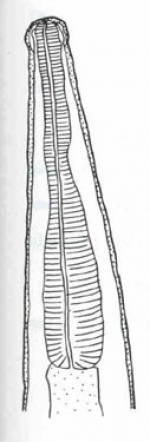NEIHPID
North-East India Helminth Parasite Information Database
Recently added
Parasites
Molecular Data
Oswaldocruzia goezei (Skrajabin et Schulz Skrajabin et Schulz)
Taxonomy
Nematoda »
SECERNENTEA »
Molineidae (Skrjabin et Schulz, 1937) Durette-Desset et Chabaud, 1977 »
Molineinae Skrjabin et Schulz, 1937 »
Oswaldocruzia Travassos, 1917 »
Oswaldocruzia goezei, Skrajabin et Schulz 1952
Synonyms
(Ascaris filliformis Goeze, 1782 ; Oswalocruzia filiformis (Goeze, 1782) Travassos, 1917; O. indica Lal, 1944; O. melanosticti Gupta, 1960)
Host
Bufo (melanostictus), Euphlyctis (cyanophlyctis), Ichthyophis (glutinosa)
Habitat
Intestine
Locality
Shillong (Meghalaya), Sumer (Meghalaya), Byrnihat (Meghalaya), Khliehriat (Meghalaya), Anogiri (Meghalaya), Kohima (Nagaland), Dimapur (Nagaland)
Description
Body very slender, white or whitish grey in colour, tapering at both ends. Cuticle of head end inflated, with transverse striations, longitudinal ridges, i.e., synlophe, present. Mouth small, with indistinct lips. Buccal cavity small, with chitinous lips. Oesophagus club shaped.
Male
Body 4.66-5.63 mm in length, 0.108-0.132 mm in maximum width. Spicules two, long, bluntly pointed, equal; divided distally into 4 or 5 branches; gubernaculum absent. Bursa well developed with large lobes; ventral rays of bursa close together, equal in size; lateral rays equal, antero-lateral rays divergent from other two which are closely apposed; externo-dorsal rays rising from base of dorsal ray, proximally parallel to trunks of lateral rays but distally diverging from postero-lateral rays; dorsal ray long, stout, cleft distally into two pairs of small accessory branches, again into several short, terminal digitations.
Female
Body 9.183-12.364 mm in length, 0.116-0.196 mm in maximum width. Ovaries two, amphidelphic condition of uterus. Vulva post-equatorial in posterior half of body. Eggs numerous, small, oval, a few containing embryos, 0.072-0.095 x 0.044-0.054 mm. Tail tapering to bluntly rounded point with terminal, spike-like filament.
Remarks
Skrjabin and Schulz (1952) gave a new name O. goezei to the species described by Travassos, (1917) from B. bufo and other amphibians by the name of Oswaldocruzia filiformis (Goeze, 1782) Travassos,1917. (According to Skrajabin et al, (1954), who revised the genus Oswaldocruzia, the original description of Ascaris filiformis, owed to Goeze (1782), has insufficient content and lacks species diagnostic indications. Therefore, in their opinion O. filiformis (Goeze, 1782) is a species inquirenda. However, in literature this species has been re-described or recorded under the same name i.e., O. filiformis by many authors (ref. 1954).From India, Baylis and Daubney (1923) reported it from B. melanostictus from Nicobar Islands. Lal (1944) described a new species, O. indica from B. melanostictus and R. cyanophlyctis from Uttar Pradesh, which was not considered to be valid by Skrjabin et al, (1954). Gupta (1960) described yet another species, O. melanosticti from erstwhile East Pakistan (now Bangladesh). Both these species are considered con-specific with O. filiformis.
Helminthological collections record
NEHU/Z - TA/12
Specimen Type
Holotype: W7768/1 (male); W7769/1 (female) in Zoological survey of India, Kolkata.
References
Skrjabin, K. I., Shikhobalova, N. P., Schul'ts, R. S., Popova, T. I., Boev, S. N. and Delyamure, S. L. (1952) Descriptive catalogue of parasitic nematodes. Vol. 3. Strongylata (in Russian), Izdatelstvo Akademii Nauk SSSR, Moscow.
Travassos, L. P. (1917). Trichostrongylidae brazileiras. Oswaldocruzia n. gen. Memorias do Instituto Oswalds Cruz.31:pp 73.
Skrjabin, K. I. Shikhobalova, N. P. and Schul'ts, R. S. (1954). Essentials of Nematology. Vol. III, Trichostrongylids of Animals .
Goeze, J. A. E. (1782). Versuch einer Naturgeschichte der Eigeweidewurmer thierischer Korper. xi 471 pp. Blankingburg.
Baylis, H. A. and Daubney, R. (1923). A further report on parasitic nematodes in the collection of the Zoological Survey of India. Records of Indian Museum. 25: pp 551-578.
Lal, M. B. (1944). A new amphibian trichostrongylid. Current Science, 13 (4): pp 104-105.
Gupta, S. P. (1960). Nematode parasites of vertebrates of East Pakistan. VI. Amplicaecum cacopi, Thelandros sp., Rhabdias ranae and Oswaldocruzia melanosticti sp. nov. from frogs. Canadian Journal of Zoology.38:pp 748 - 750 .



.jpg)
